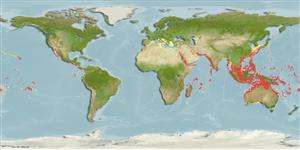Gastropoda |
Neogastropoda |
Nassariidae
Environment: milieu / climate zone / djupintervall / distribution range
Ekologi
Revassocierade; djupintervall 1 - 110 m (Ref. 101020). Tropical
Indo-Pacific and the Mediterranean: from East and South Africa, to western Polynesia; north to Japan and south to central Queensland and New Caledonia.
Length at first maturity / Size / Weight / Age
Könsmognad: Lm ? range ? - ? cm Max length : 4.0 cm SHL hane/ej könsbestämd; (Ref. 349); common length : 3.0 cm SHL hane/ej könsbestämd; (Ref. 349)
Sometimes found in local markets (Ref. 349). Shallow subtidal zones (Ref. 349). Most Nassariidae are omnivores and facultative scavengers (Ref. 108572).
Life cycle and mating behavior
Könsmognad | Reproduktion | Lek | Eggs | Fecundity | Larvae
This species is a non-broadcast spawner. Life cycle does not include trocophore stage. Also Ref. 833.
Poutiers, J.M. 1998 Gastropods. p. 363-648. In Carpenter, K. E. and V. H. Niem. 1998. FAO species identification guide for fishery purposes. The living marine resources of the Western Central Pacific. Volume 1. Seaweeds, corals, bivalves, and gastropods. Rome, FAO. (Ref. 349)
IUCN Red List Status
(Ref. 130435: Version 2025-1)
CITES status (Ref. 108899)
Not Evaluated
Not Evaluated
Threat to humans
Human uses
| FishSource |
Verktyg
Ytterligare information
Trophic EcologyFood items (preys)
Födosammansättning
Födointag
Predatorer
Population dynamicsTillväxt
Max. ages / sizes
Length-weight rel.
Length-length rel.
Length-frequencies
Mass conversion
Abundans
PhysiologySyreförbrukning
Human RelatedStamps, coins, misc.
Internet-källor
Estimates based on models
Preferred temperature
(Ref.
115969): 23.6 - 29.1, mean 28 (based on 2396 cells).
Fishing Vulnerability
Low vulnerability (10 of 100).
Price category
Unknown.
